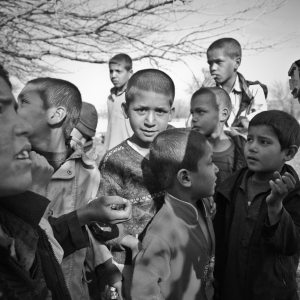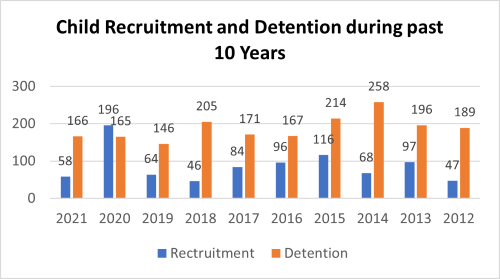Reintegration Services for children recruited or used by Armed Forces or Armed Groups in Afghanistan

Blog post by Menhajuddin Hamed (Menhaj)
Introduction
Child recruitment and use by armed forces and armed groups is a global issue and thousands of children are recruited or used by parties to armed conflict in most of the in-conflict countries around the world (UNICEF, 2021). The rights of children to education, development and freedom are violated in armed conflicts, and young children are recruited and used by armed forces and armed groups in different capacities in the context of armed conflict. This often leads to tragic and sometimes irreversible consequences for the children involved, their families and their communities. Children are often killed, maimed, orphaned, kidnapped, and deprived of their education and health care, and experience profound emotional and psychological trauma (UNICEF, 2009).
In Afghanistan, several decades of armed conflicts have caused the highest numbers of child recruitment and use in the ranks of armed forces or armed groups in the world. During the year 2020, the United Nations verified and documented the cases of 2,863 children directly affected in armed conflict out of which 196 were recruited or used by parties to the armed conflict (United Nations, 2021).
My study aims to provide answers to the questions: How can be contextualized reintegration services provided for children released from their association with armed forces and armed groups in Afghanistan? How children are affected by the impact of the ongoing armed conflict in Afghanistan, why children are associated with armed forces and armed groups and what protective and reintegration services are needed to protect these children and prevent their re-recruitment. The study aims to highlight some specialised interventions when responding to the needs of child solders released. You may watch more on this in a new video by Menhaj at: https://youtu.be/4dR5xwHYgXA
Brief Overview of Child Soldiers in Afghanistan
Although the country must be bound by international laws, unfortunately during the five decades of war in Afghanistan, children have been recruited or used by parties to the armed conflict in various ranks of the armed forces and armed groups. Only in the year 2003, 7,444 underage soldiers were disarmed, separated from the armed forces and armed groups and somehow reintegrated with their families through the UN efforts on the release of children (UN Security Council, 2008). However, during the consequent years, the UN annual reports have indicated that a large number of children have been recruited or used in the ranks of the parties to the armed conflict. According to the report of the Coalition to Stop the Use of Child Soldiers (CSUCS), nearly 5000 former child soldiers were reintegrated and included in the services in the country during the year 2007 (CSUCS, 2008). During the past years, recruitment and use of children was reported more from the areas of intense conflict, especially in the South and along the border between Afghanistan and Pakistan (Katrina, 2013).
 During the past ten years, around 2749 children (all boys) are either recruited in the ranks of armed forces and armed groups or detained in the Juvenile Rehabilitation Centre (JRCs) charged with the accusation of activities against national security.
During the past ten years, around 2749 children (all boys) are either recruited in the ranks of armed forces and armed groups or detained in the Juvenile Rehabilitation Centre (JRCs) charged with the accusation of activities against national security.
The Figure (right) shows the number of children recruited/ used by parties to the armed conflict and the number of children detained in the JRCs in Afghanistan during the past 10 years.
These are the cases verified by the UN CTF MR and reflected in the UN Secretary General’s Annual reports on children and armed conflicts (UN General Assembly Security Council, 2012-2021). There might be more children recruited or used by parities to the armed conflict that could not be verified due to the harsh territorial circumstances and the under reporting of cases.
References:
Katrina, L. (2013) Not Suitable for Children: The Politicisation of Conflict-affected Children in Post-2001 Afghanistan. Australian Journal of International Affairs. [Online], Vol. 67, No. 4, pp. 475-490, Available at http://dx.doi.org/10.1080/10357718.2013.803031. (Accessed 12 September 2022).
The Coalition to Stop the Use of Child Soldiers (CSUCS) (2008) Child Soldiers Global Report. [Online], Available at www.child-soldiers.org. Accessed 18 October 202
United Nations Children’s Fund (2021) Children Recruited by Armed Forces.[Online], Available at www.unicef.org/protection/children-recruited-by-armed-forces. (Accessed 22 June 2022).
United Nations Children’s Fund (2009) Machel Study 10-Year Strategic Review: Children and Conflict in a Changing World. [Online], Available at UNICEF publications | UNICEF (Accessed 18 October 2022).
United Nations General Assembly Security Council (2021) Annual Report of the Secretary-General on Children and armed conflict. [Online], Available at https://childrenandarmedconflict.un.org. (Accessed 23 June 2022).
United Nations Security Council (2008) Report of the Secretary-General on children and armed conflict in Afghanistan.” New York: United Nations. [Online], Available at https://digitallibrary.un.org/?ln=en. (Accessed 18 October 2022).
United Nations General Assembly Security Council (2012-2021) Reports of the Secretary-General on Children and Armed Conflict. [Online], Available at https://www.securitycouncilreport.org (Accessed 27 December 2022).
.jpg)
Menhajuddin Hamed (Menhaj)
Menhaj is an Afghan Law Lecturer currently doing his fellowship programme at the Law and Business Facility of the Open University in the UK. His major expertise is in the fields of juvenile justice, human rights, family law, Islamic law and general legal subjects.
He has worked in the area of child protection in Afghanistan for more than 10 years. Menhaj has additional expertise in child protection social work and child protection in emergencies.
Mr Hamed has two master’s degrees, one in Law (LLM) from the University of Washington Seattle USA and the second in social sciences (advanced child protection) from the University of Kent in the UK.
He is based in Glasgow with his family and working on his research online under the supervision of Dr Neil Graffin from FBL. His research topic is: A Qualitative Study on Reintegration Services for Children Recruited or Used by Armed Forces or Armed Groups in Afghanistan.
You can follow Menhaj on YouTube at: Menhajuddin Hamed منهاج الدین حامد - YouTube and Facebook at: Menhaj Hamed | Facebook and Linkedin at: (1) Hamed Menhajudin | LinkedIn